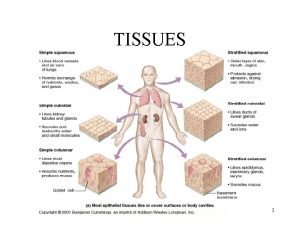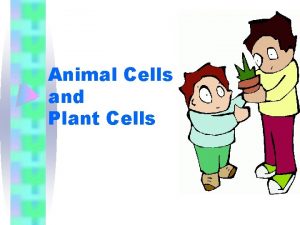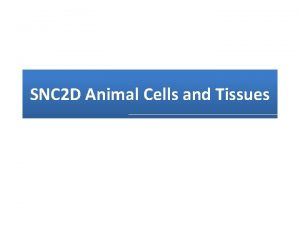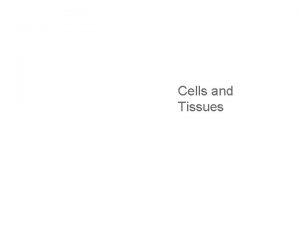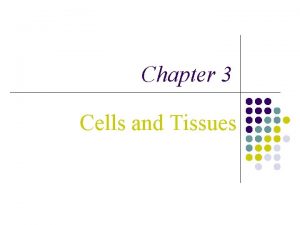SNC 2 D Animal Cells and Tissues What













- Slides: 13

SNC 2 D Animal Cells and Tissues

What factors influence cell specialization in Animals? • Take a look on p 85 and take a couple of minutes to read the page • The contents of the cell’s cytoplasm • Environmental conditions (like temperature) • The influence of neighbouring cells

The Effect of Cytoplasm on Cell Specialization • After cytokinesis, the contents of the cytoplasm may differ in each daughter cell • This helps determine what type of cell it will become

The Effect of Environmental Conditions on Cell Specialization • For example, in siamese cats, only cells that develop at cool temperatures produce dark hair colour (this usually occurs at the tips of cat’s feet, tail, ears, and nose)

The Effect of Neighbouring Cells on Cell Specialization • When cells are close to each other, substances can diffuse through the cell membrane • These substances change which genes in DNA gets expressed • For example, in the embryo of a chick, neighbouring cells influence eye development in a specific location in the embryo • 16 days embryo

Chick Development 6 Days 10 Days 16 Days

Abnormal Development • Chemicals (contaminants like heavy metals) in the environment can affect an animal’s development • In humans, 90% of developmental issues can be traced to environmental factors!

Structural Organization of Multicellular Organisms atoms ↓ molecules ↓ organelles ↓ cells ↓ tissues ↓ organ system ↓ organism

Review Chemical – atoms combine to form molecules Cellular – molecules interact to make up cells Tissue – cells are grouped into tissue Organ – tissues compose organs Organ system – organs function together to form organ systems Organism (individual) – made up of the organ systems

Levels of Structural Organization Atoms Molecule Organelle Cell Tissue Organ System Organism

Necessary Life Functions • Ideas? • Maintaining boundaries – Cellular level – accomplished by plasma membranes – Organism level – accomplished by the skin) • Movement • Responsiveness • Digestion • Metabolism • Excretion • Reproduction • Growth

Cells that have the same Function form Tissues • Despite there being millions of different organisms, there are only a few different types of tissues!

What are the different tissues? • Find out for yourself! Fill in your chart of Animal Tissues using the hand out • For homework, answer questions p 76 #2 -5 (on the Nelson Textbook Handout)
 Body tissue
Body tissue Body tissues chapter 3 cells and tissues
Body tissues chapter 3 cells and tissues Body tissues chapter 3 cells and tissues
Body tissues chapter 3 cells and tissues Chapter 3 cells and tissues
Chapter 3 cells and tissues Eisonophil
Eisonophil Animal cell venn diagram
Animal cell venn diagram Chapter 3 cells and tissues
Chapter 3 cells and tissues Chapter 3 cells and tissues figure 3-1
Chapter 3 cells and tissues figure 3-1 Anatomy of a generalized cell figure 3-1 answer key
Anatomy of a generalized cell figure 3-1 answer key Tissues are groups of similar cells working together to
Tissues are groups of similar cells working together to Tissues are groups of similar cells working together to
Tissues are groups of similar cells working together to Where are loins on a human
Where are loins on a human Tissues are groups of similar cells working together to:
Tissues are groups of similar cells working together to: Hhps symbols
Hhps symbols










